Global Furniture Industry Highlights
2009/05/07 | By CENSJapan's Furniture Imports and Exports in the First Half of 2008
Japan's furniture imports in the first half of 2008 totaled approximately ¥244.17 billion, down 7% compared with results for the same period last year. For the first time in many years Japan's furniture imports demonstrated year-on-year negative growth, though a half-year term.
Based on the first-half results, total imports for the full year are estimated to be approximately ¥488 billion, which is likely to decline from the previous year's result that exceeded the ¥500-billion yen mark and even the value in 2006, which was ¥480.6 billion.
The negative growth of total imports has directly affected the growth rates of the top furniture exporters to Japan. China, the top exporter whose rapid growth since 2000 has outpaced all other exporters, finally registered a negative growth rate of 0.6% for the first time over the past dozen years or so. Imports from China decreased from approximately ¥125.06 billion in 2007 to approximately ¥124.4 billion in 2008.
Second ranking Vietnam, a fast-growing furniture exporter to Japan following to China, recorded approximately ¥14.93 billion, down 10.6% from the previous year, which far outpaced China's negative growth rate. Among top 10 furniture exporters, seven countries besides China and Vietnam-Taiwan, Thailand, Mexico, Indonesia, Germany, Italy and the U.S.-demonstrated year-on-year negative growth, while only Malaysia registered positive growth. In particular, Thailand (Asia), Germany and Italy (EU), Mexico (South America), and the U.S. marked a two-digit negative growth rate in the current term.
Japan's furniture exports in the first half of 2008 totaled approximately ¥60.19 billion, up 23.7% over the same period last year. Based on this figure, furniture exports are increasingly likely to exceed the ¥120 billion mark by the year-end for the first time ever.
The top-10 importers of Japanese furniture include the U.S., which recorded approximately ¥12.99 billion, up 5.3% from the previous year; China in second place with approximately ¥12.96 billion, up 29.7%; and the U.K. in third place with approximately ¥5.73 billion, up 3.3%; followed by Thailand, Mexico, Indonesia, Taiwan, Brazil, the Philippines, and Australia. Six countries-China, Taiwan, Thailand, Mexico, Indonesia, and the U.S.-have large share in both furniture exports and imports in Japan. In terms of export-import balance, however, Japan's furniture imports excess over exports, shows substantial trade deficits with all trading-partner countries. (Excerpted from Japan's Home Living World, Oct. 2008, No. 39)
Tech Providers Offer E-Commerce Site Help
By Cary Evans
Retail technology providers are finding that online commerce is a hot topic these days, particularly as a means for retailers to brand their stores and products and become more interactive with prospective customers.
"When it comes to e-commerce, the numbers speak for themselves," said Gloria Walsh, product marketing manager for Storis Software Solutions. eStoris, the company's online application, has a variety of services that allows customers to see and price retailer's product, check its availability, buy it and follow the progress of delivery.
According to Comscore, an Internet performance and consumer behavior site, almost three-quarters of all customers shop the Internet before making a purchase. Online purchases in 2007 for big-ticket items increased 67%, said Walsh, for close to US$1 billion in total sales.
"Google is not just a search engine. It's a verb," Wash said. "People 'Google' brands and products they want to research jobs, salaries, even potential dates. When it comes to your company, what do you want customers to see when they type 'XYZ Furniture?' If you don't have a Web site that defines your brand and your style of service, your are at the mercy of competitors, disgruntled employees and dissatisfied customers."
Wash said consumers shop the Web for a number of reasons.
First, they like the convenience of being able to investigate brands and comparison shop. They also like the privacy-they can shop without sales pressure and apply for credit online instead of doing it in the store.
Then there's customer service. People appreciate e-mails, Wash said, informing them when merchandise arrives or delivery dates change due to shipping delays. They also like "thank you" e-mails, targeted discounts and coupons based on brand or merchandise interest. Such service can encourage repeat business.
For working families and other busy people, the Internet allows customers to shop more efficiently, saving time, gas and money.
A Forum for Feedback
Finally, there's the review factor-dozens of Web sites feature positive and negative reviews of products and services written by actual customers.
But doing business with the help of the Internet can be a two-edged sword. Walsh cautioned retailers to remember this axiom: If customers like your product, they will tell two people; if they don't, they'll tell 10. And with Web site like complaints.com, displeased and disgruntled users can potentially tell hundreds, if not thousands, about dissatisfaction.
"Add that to the blogging community and social networking sites where like-minded users forward information to others, and the numbers increase dramatically," she added, noting that once on the Web, information is hard to remove.
Walsh recommends that retailers have an abundance of information on their sites about how well they treat their customers, so if an online complaint does surface it will seem like an atypical event. Invite positive feedback by creating an area on the Web site where customers can communicate how satisfied they are with your service.
Shelley Parlin, vice president of professional services for ProfitSystems, said the company has noticed a growing interest in e-commerce among its retail clients and now keeps the Internet in minds as it develops software.
"Retailers are using their Web sites as a way to brand their business, show merchandise, and offer clients a way to sign up for newsletters and even download cleaning and maintenance tips for their furniture," Parlin said.
Having an online presence is becoming more essential, especially as younger groups like Gen Y gain purchasing power, Parlin said. "Doing business online is on the forefront of the clients' minds. Quite honestly, that's why we're pursuing it corporately. The response has been overwhelming because of their interest."
The Pew Internet and American Life Tracking study, conducted in May of 2008, found that 73% of the adult population in America uses the Internet, up from 71% of 2007. Similarly, The Prospective Marketing Survey Group, in a study released in February of the same year, found that 66% of respondents reported they were spending more time online researching consumer goods, and 74% welcomed more brand e-newsletters, online offer and coupons.
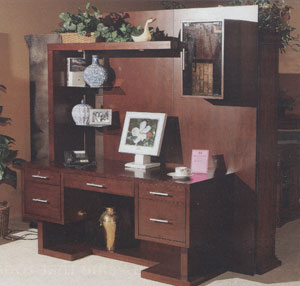
Effective Web sites can encourage consumers to visit regularly. To do this, Forte suggests that dealers refresh their home page content on a regular basis, promote special offers and showcase products.
Creating Community
"Create a sense of community," said Forte, "by using a writing tone that resonates with the target audience. The consumer should be able to visualize furnishings in their own home environment. Large, up-close and professional quality photos that depict furniture in an attractive setting are invaluable-contributing to the credibility of the brick-and-mortar store. These efforts result in an increase in customers' confidence to purchase furniture." (Excerpted from Furniture Today issued Sept. 22, 2008, Vol. 33 No. 4)
Small-scale Home Office Connects With Buyers
By Larry Thomas
Smaller-scaled desks that fit easily into a guest room, great room, or even a kitchen attracted considerable attention in market showrooms displaying home office products.
Home office resources said the slimmed-down products are gaining in popularity because they take up less space on the retail floor-and in the consumer's home. Plus, they allow a retailer to hit a lower price point and make the category more affordable to a wider range of potential customers.
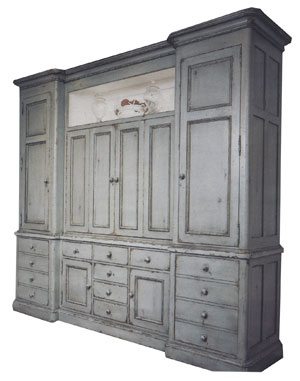
Karl Eulberg, senior vice president of sales at Kathy Ireland Home by Martin, agreed, noting that the move to downsize also is driven by growing consumer preference for laptop computers instead of desktop models.
Although he and other executives said new home office pieces were well-received at market, they admit they are a bit frustrated by the lack of excitement in the category as compared with, for example, home entertainment furniture. "There's no flat-screen TV to drive sales of home office," said Tim Donk, director of marketing at Legends Furniture.
However, executives said buyers embraced a number of smaller-scaled items, as well as several so-called "gathering height" desks that double as compact workstations. Such desks typically are 30 inches to 34 inches high - 6 to 8 inches taller than other desks - which gives users the option to stand while working. Additionally, they often include features such as charging stations for personal electronics.
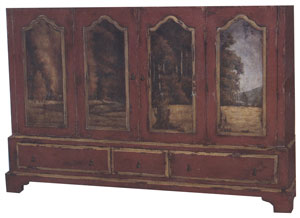
Another contemporary success story at market was BDI, a company that made its debut in the home office category. BDI's Sequel home office group has features such as dark tempered glass that can accommodate an optical mouse, as well as a wire management system that hides wires between a pair of magnetically attached lower panels on the desk.
Also making its debut in home office was Sunrise Home Furnishings, a resource best known for its entertainment consoles. Bob Lephart, vice president of sales and marketing, said the company's new laptop computer desks, peninsula desks and computer armoires can be mixed in a container with its entertainment furniture. "Our laptop desks were a big success," Lephart said. "They are really functional and inexpensive." (Excerpted from Furniture Today issued Nov. 3, 2008, vol. 33, No.9)
Entertainment Active at Top End of Market
By Larry Thomas
Although the marketplace is awash in US$399 television consoles that continue to sell briskly, the upper end of the entertainment furniture market is doing quite nicely in its own right, thanks to a variety of innovative features and styling.
Upper-end resources say the flat-panel television phenomenon is helping them just as much as those who promote promotional and mid-priced goods because high-end consumers can afford to spend more on the furniture that goes with their TV purchase.
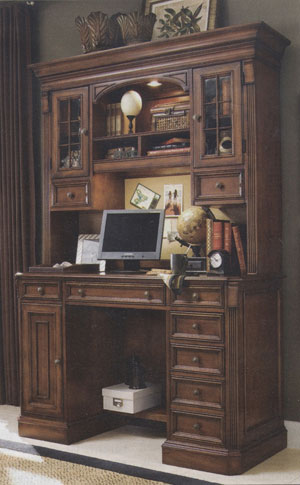
Upper-end resources also have developed units that can be heavily customized, which also is a boon for higher-income consumers and the interior designers they often employ.
Designing Growth
"Our interior design business is way ahead of last year, and one big reason is because interior designers enjoy the customization that we can offer," added Rob Slight, president of Sligh Furniture.
Sligh's High Point market introductions included a wall system with a motorized plasma TV lift unit that retails for about US$10,000, as well as a TV console program that allows consumers to choose the size, height and storage features of their customized unit.
Customization took center stage at Harden Furniture's High Point showroom, where the company unveiled its Perfect Fit entertainment wall system. It allows consumers to choose from a variety of widths, depths, heights and drawer sizes, among other things.
"Whether they are using an interior designer or not, today's high-end consumer wants it the way they want it," said CEO Grey Harden.
Harden said the variety of heights appears to be the most popular element of customization because it allows the wall system to fit in a variety of ceiling heights.
Armoires Still Active
While features such as wire management, ventilation and extensive media storage are commonplace throughout entertainment pieces at all price points, the high end remains something of a bastion for the traditional bedroom armoire-a product that has all but disappeared from promotional and mid-priced lines.
Jukanovic said virtually all of Marge Carson's bedroom suites include an armoire that has been designed to accommodate flat-panel televisions.
At Hekman, the entertainment furniture emphasis in recent years has shifted to TV consoles and wall systems, said Neil Mckenzie, vice president of sales and marketing. He said tall consoles, such as the 37-inch-high model, are rapidly gaining in popularity with Hekman customers.
Hekman's consoles typically retail for US$1,099 and up, while its larger wall systems carry retail tags of US$5,000 or more. (Excerpted from Furniture Today issued Nov. 17, 2008, Vol. 33, No. 11)
Changing Lifestyles Take Desks to New Levels
By Larry Thomas
Instead of crowding around the kitchen table to discuss homework assignments, meetings and soccer practices, a number of today's busy families have found a new gathering spot-the home office.
But to producers of home office furniture, that doesn't necessarily mean a traditional home office that's tucked away in a spare bedroom.
Increasingly, such "offices" are found in the corner of a great room, family room, or even the kitchen-settings that aren't always suitable for a traditional executive desk or computer desk.
That's why several leading producers have developed desks that are 5 to 10 inches taller than traditional desks. Often called counter-height or gathering-height desks, producers say this new generation of desks is trying to meet the needs of active families who don't have the space to devote to a more traditional home office.
"The counter-height desk configurations, paired with informal counter stools, create a more casual environment that works well in these rooms," said Michael Foster, vice president for case goods merchandising at Broyhill.
Such configurations often include USB ports and charging stations for iPods, laptop computers and cell phones. And at least one producer-Sligh-has included space for a small flat-panel television.
"It's a great family gathering area and it's also great for people with back problems," said Hank Long, senior vice president for merchandising and design at Hooker. "You can stand up and work if you like."
Because they're located in more "public" areas of a home, most tall desks are designed to be used by several family members-thus the multiple storage compartments and numerous charging stations for everyone's personal electronics.
Sligh, in fact, calls its product the Family Communications Center. Introduced in October 2006 at the High Point Market, the unit quickly became a top-seller.
Kitchen Coordination
Long said Hooker's Smart Works Home Center was a winner at its market debut in October of 2008 in High Point, while Foster said Broyhill has done well with several counter-height desks that are part of its Office2Home collection.
Foster said his company is trying to capitalize on the consumer's desire to put such products in kitchens, so it has developed four finish options that coordinate with existing kitchen cabinets.
"Smaller counter-height desks can work well in a kitchen setting because the surface can be positioned next to existing kitchen countertops," he said.
Long and others say the ability to stand while working at the desk doesn't just benefit those with back problems-it can prevent them from occurring in the first place. That's one reason Danish manufacturer Jesper Office has been successful with a desk that features a motorized adjustable desk top.
The unit, appropriately named the Sit-Stand Desk, adjusts between 25 inches and 52 inches high. "In many European countries, office workers are required to stand and work at their desks for part of the day," said Thomas Kristjansen, product manager at Jesper's U.S. headquarters. :"This (adjustable desk) concept is starting to catch on in the U.S. because of the increased interest in ergonomics." (Excerpted from Furniture Today issued Nov. 24, 2008, Vol. 33, No. 12)
Two-Over-Twos Gain Steam in Leather
By Joan Gunin
Two-over-two styling, a popular look in fabric upholstery, is now spilling over into leather.
The look, seen most often on smaller-scale contemporary and casual frames, is gaining strength as an alternative to more traditional three-over-three seating.
The split cushion is a style statement first and foremost. But such frames also can be less costly to produce because less material, labor and time are needed. In addition, the two-over-two entries add diversity to retailers' upholstery assortments.
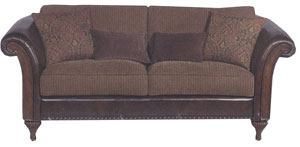
Two-over-two styling is more widely used in contemporary than traditional looks "because that (contemporary) customer seems to like it better," Bleile added.
But such a silhouette can present at least one design drawback. "You have to be cognizant of the width of the sofa because if the frame is too wide, the silhouette resembles what I call a 'tootsie roll effect'," Bleile said. "The proportions have to be believable. Usually the arm dictates the sofa width."
For a two-over-two model with a standard-size arm, Bleile recommends a width no larger than 85 inches.
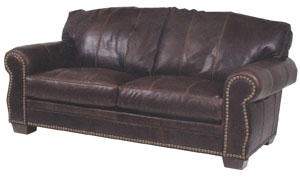
Sue Dunn, vice president of merchandising for Michael Thomas, said two cushions offer a more comfortable, bigger sit compared to formal three-seaters. And John Grootegoed, national sales director for Passport Home, a value-oriented import line, said two-cushion sofas offer a good bridge for both modern and traditional aesthetics.
David Wormald, leather merchandise manager for Lane Home Furnishings, said two-over-two models offer compelling cost savings.
With fewer cushions and zippers and less cording and leather hide needed. "It comes down to labor and costing," he said. "Engineering can be part of the decision-making. Take out a couple of inches and some leather and yes, it can be a savings."
Two-over-twos typically measure from 82 to 84 inches wide versus their three-seat counterparts, which run 86 to 90 inches, Wormald said.
But Tamra Wainscott, merchandise manager for Craftmaster, said cost is not much of a consideration for her company when it comes to two-over-twos. "It is a question of look and style, fabric application and adding to the assortment," she said. "We look to see what we have in the line in order to create a well-rounded assortment."
Split styling does not get the attention it deserves, according to Kim Long, director of merchandising for Classic Leather and Statesville Chair. "It is a great way to achieve a lot of comfort in a smaller-scaled sofa," she said, citing 76 inches as an optimal size.
"The two-over-two concept also creates a feeling of coziness that you do not have in the traditional three-over-three sofa," Long said. "In smaller sofas, three-over-three can start looking a little choppy or fussy, so this alternative provides a cleaner, more streamlined look." (Excerpted from Furniture Today issued Dec. 15, 2008, Vol.33, No. 15)
Comfort Zone
From the sheer number of companies dedicated to this segment of the market and the obvious presence they exert at the shows, bed manufacturers and wholesalers are a critical and much-needed part of the furniture industry.
From bed frames and headboards to specialist mattresses, the choice is vast. And even within these categories, the breath of styles is ever-evolving, as the designers turn their creative attention to niche, target markets.
Silentnight, for instance, has produced a fabulous looking bed for the teenage market. Named the Chill-Out, it was developed as a result of the company's research, which found that teenagers need a multi-functional space to call their own. This new concept provides just that, as it is not just a bed, but a space for teenagers to "live their life in."
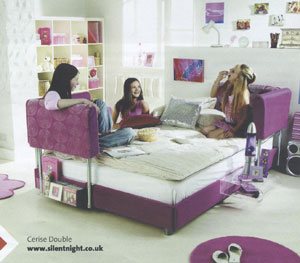
The double and single options come in a fashionable design using mesh fabric and metallic colors in cerise and charcoal, and the easy-clean fabric on the bed means that any spillages can be dealt with.
Furthermore, the single version comes with a sleepover option where the mattress will lift off to reveal an occasional sprung bed built into the base, meaning any friends can stay over. Maybe not what parents want to have, but certainly, for the sales person, it adds to the list of features.
The bed also comes with clear acrylic accessories including a picture holder, side table and storage bin, perfect for storing a teenager's essential items and keeping them tidy.
The bed also features practical considerations in the design for a good night's sleep. Silentnight's exclusive Miracoil spring system (with its concentrated center third of the mattress) creates a supportive Posture Zone where the body needs it most and guarantees comfortable support during sleep. The mattress is also easy to care for with the double mattress being single-sided so there is no need to turn it.
"Memory foam continues to be the buzz world, but on it's own it's not enough," Stuart Hibbert at Breasley says. "The days of selling a memory foam mattress purely on the depth of memory foam has long gone."
"The consumer is much more demanding and prepared to spend time researching all the options available to them, and has a much greater understanding of this relatively new product," he adds.
As one of the UK's largest independent foam converters, Breasley is able to develop exciting new ways of using foam and memory foam to produce new models with innovation.
In addition to 'state-of-the-art' foam conversion machinery, Breasley has invested heavily in its own pocket spring machines, giving the company flexibility and independence.
The Salus bed collection has a very contemporary look, combining traditional pocket springs with memory foam and latex. The mattresses are foam encapsulated and all have removable covers for easy cleaning. The divan bases are upholstered in high quality fabrics with matching full height headboards.
Durabeds not only manufactures mattresses of quality, its product's features are worth talking about too. As its name suggests, the Duet Memory includes two-inch layer of memory foam. Both this and the Duet Deluxe models are 'turn free'. Duet Deluxe Twin Spring comes with the tag line. "Twice the Comfort, Twice the Support" and this is down to the micro-quilted high-quality woven damask cover and layers of upholstery on an extra firm double-decker spring unit (twin spring).
"This mattress has twice as many springs as an ordinary bed and combines well with a platform top divan base for additional comfort and support," says Gina Paterson. Adding, "And it is available with and without storage."
The Duet Memory model has twin spring with memory foam. Micro-quilted into luxurious knitted fabric, it is combined with two inches of high-density memory foam for a truly sumptuous feel. "Visually and demonstrably there is a lot of mattress for the consumer to view, and in addition, a great deal for the retail sales person to discuss and justify the price point," states Paterson. "In this day and age, when the consumer is being particularly vigilant about the pound in her pocket, this represents incredible comfort and outstanding value for money."
Sweet Dreams has an extensive collection of bedsteads, and more are promised for 2009. Hudson is one of Sweet Dreams' favorite wooden bedsteads. In pine, with a wide slat base, it was a driving force in the company's expansion into bedroom cabinets in 2008. "Retailers were regularly asked for matching cabinets to the very popular bedstead," explains sales manager, Jackie McGarvey. "As a result, matching wardrobes, chests of drawers, mirrors and bedside cabinets were launched-together with other new bedsteads with matching bedroom furniture. The Hudson bedstead also has storage built in."
McGarvey goes on to comment that, in terms of popular trends, upholstered and wooden bedstead have been in vogue for past few years. For 2009, she predicts a new trend in high gloss, as evidenced in Brando, a bedstead with matching cabinets which is new for 2009. The range features walnut laminate with black high-gloss contrast panels.
Customer satisfaction, including swift delivery, is crucially important to everyone. Keeping it top of the priority list, national retailer Dreams backs up a strong high street and online presence with keeping delivery promises, and professional customer service backup.
Selling three types of bed frame (metal, wood and upholstered), the outfit also offers a huge range of beds and mattresses, as well as bedroom furniture, bedding and bed linen.
"Dreams is a fun, family and friendly brand with a reputation for quality, value for money and excellent customers service," says Nick Worthington, CEO. "We create an atmosphere where customers feel relaxed, comfortable and cared for. As the brand leader, we keep our finger on the pulse of new bed and mattress technology, as well as the latest trends, to ensure our range is kept fresh and up-to-date." (Excerpted from the United Kingdom's Cabinet Maker issued Dec. 5, 2008)
Ethical Design
For many of those involved in the furniture profession, the issue of sustainability is about having a conscience, doing your "bit" and also homing in on the greater social principles of our society.
Before you think this is an invitation to start making placards and hugging trees, the issue of sustainability is a serious one and one that you can contribute to-whether that is as a designer, manufacturer, importer or retailer.
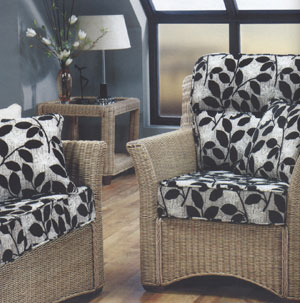
The correct avenue for Walker began with approaching the charity TreeAid, which deals not only with African woodland issues, but also helps a considerable amount of people. "About 300,000 people benefit from the charity's work which means that the profits are reinvested to help them be self-sufficient and develop their own businesses."
Now a partner with the high-profile charity, Ecofurn works exclusively with plantation timbers, which are replanted every ten to fifteen years. All aspects of environmental impact are considered important, so even the packaging and waste products have a minimal impact. "And we do a lot of fund raising too which, along with profits, goes directly to help the people," states Walker.
Not only have strong company ethics been established in only one year, Ecofurn is delivering on style and quality too. "I'm delighted to say that we are flat out; we're very busy with a good turn over which seems to be doubling every month. I think the success is down to good brand awareness in partnership with TreeAid."
"I have a love of timber and well-designed furniture just like everyone else in the industry, but sustainability is very important for the environment. Every piece of furniture which is not forested responsibly has a knock-on effect. It's about having a conscience."
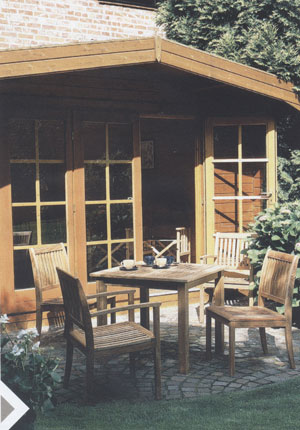
"We insist on the highest comfort and good posture," says owner David Colwell. "This encourages the greatest satisfaction and the least reason for replacement. We create timeless good looks by skilled crafts people."
"Our work is not idiot proof. Most industrial processes are aimed at deskilling production. We see this as a recipe for producing a race of half wits," Colwell adds. "We would need to take a radical look at the way we live, to take account of the finite nature of the planet."
"Now climate change is very much for real, and we have done depressingly little to alleviate the inevitable outcome (we have actually become far more profligate and probably less satisfied), I still feel that an alternative future is possible and potentially much more fun."
"On the principal that an interesting answer is most likely to come from an interesting question, I designed this furniture with sustainability high on the agenda. Really good design makes the challenges of tomorrow feasible and exciting."
In the present era of climate change warnings and carbon footprint calculations, Desser & Co., Ltd. are purporting to lead the furniture industry into a greener era, helping consumers to take a simple, eco-friendly step by selecting rattan as their natural furniture choice.
"The destruction of tropical forests is the second greatest cause of global greenhouse gas emissions. Unsustainable logging destroys tropical forests, which normally soak up CO2, whilst decaying vegetation, burning trees and disturbed soil all release carbon into the atmosphere, as well as eradicating many species of wildlife whose natural habitat is being destroyed. Almost a quarter of the world's poor depend on forests for their livelihoods and yet our activities risk the subsidence and welfare of the indigenous forest communities," says Mark Stewart, senior official of Desser.
Desser believes that consumer power can make a real difference to this issue, raising awareness of where the products come from, and the effects on the environment and native communities.
"Here at Desser we can get a little geeky about our rattan! We love the fact that our retailers know the products entering their store are sourced responsibly and sustainably and that our customers are making a well-informed and responsible choice," he states. "Rattan is an ideal sustainable alternative to hardwoods, the perfect materials for creating high quality, contemporary and classic furniture."
Rattan is a promising crop ecologically because it grows very fast-as much as six meters a year-in areas which cannot support other land products. It grows in degraded forests and marginal soil and can be introduced artificially in natural forest without disturbing the existing structure and balance.
"The real beauty as far as conservation issues are concerned is that rattan can only grow among existing trees, so it can accurately be claimed to encourage the preservation of forests. It 'hugs' the trees and saves them from the loggers axe without disturbing the natural habitat."
Rattan is ideally suited as a smallholder crop as it provides sustainable income to some of the poorest people in the world. It is easy to work with, requiring only simple tools and low-cost machinery, and generates diverse employment. Encouraging local people to trade from the forests in a sustainable way helps them protect their precious surroundings.
Good looks are high on the agenda for award-winning product design consultant Roy Tam. Know for his sustainable design lectures and specialist area of low-impact furniture, Tam's pared-down designs show Scandinavian influences, which are both efficient and people-friendly.
"Timber is ecologically head and shoulders above all the world's structural materials," states Tam. "For example, raw aluminum requires several hundred times the energy to produce compared with timber. While plastics are better, they still consume hundreds of times, and recycled plastics uses more energy again. This all translates to more CO2 emissions. Composite boards can only help to reduce landfill.
"Not only is timber the greenest, it also has a double advantage. Trees also absorb atmospheric CO2 as they grow and it 'fixes' it into its wood. This carbon acts as the world's carbon sink, and is not released back into the atmosphere unless it is burnt or decomposed."
A company which produces timber furniture is Barlow Tyrie. "We manufacture our wooden furniture from teak, which we source legally from plantations in Brazil and Indonesia," says Marketing Manager David A. Evans. "The private plantation from which we have sourced our Teak in Brazil has just attained FSC certification. Nearly all Teak in Indonesia comes from government owned plantations on the island of Java. If properly managed, this source would qualify for FSC certification and a few forest districts achieved this recognition between the years 1998 and 2000."
Audit Proforest is an independent company that specializes in the formulation, implementation and monitoring of policy leading to sustainable forest management. "In 2004, we asked Proforest to undertake an audit on the legality and sustainability of the Teak we source for our production. Their audit report confirmed this to be the case. Our policy is to move as quickly as possible to the FSC certification of most of our furniture," he states.
Known throughout the U.K. and Ireland as an innovative importer, Blue Bone has developed a key range of reclaimed furniture-Teak occasional and bedroom ranges.
Test marketing of the bed and dining tables began almost two years ago and, with good response, further design and development has delivered a comprehensive range. Sleek, contemporary and full of storage and practical considerations, the occasional pieces have expanded to include items such as a mirror, glass fronted cabinets and large storage cabinets (which can be used in the kitchen as well as living spaces).
Delivering quality of design and integrity of source, steps towards greener homes and, ultimately, a more eco-friendly environment, can be achieved. And, with increasing consumer interest and awareness, sustainable furniture is becoming an integral part of the UK furniture industry. (Excerpted from the United Kingdom's Cabinet Maker issued Oct. 31, 2008)
Outlook for 2009
2009 is set to be a very exciting year for the UK furniture manufacturer market. Despite the problems facing the overall UK economy, the players in the UK furniture manufacturer sector need to be prepared for a series of unique opportunities that will present themselves in the year ahead.
On the surface, the overall furniture manufacturer market is not in bad shape. Sales growth is running at a little over 5.2%, which is up in fact on last year. However, even the most bullish of companies will need to rethink for 2009. Plimsoll predicts that the overall market will see very little growth, if any. Already, more than half of all UK furniture manufacturers companies have seen a decline in sales as the impact of the wider economy moves to the market.
Where opportunities to increase sales do not materialize, this is sure to be at the expanse of other, weaker players in the market. But for a select group of 139 companies, 2009 could be their year. These companies, many of whom are offering low-cost alternatives, could capitalize as businesses and consumers alike seek to reduce costs.
Historically, profitability in the UK furniture manufacturer market has been very uneven; we've seen a select band of 59 super profitable players delivering 18% margins, while most of the other companies are achieving 3.7% margins at best, with loss making not uncommon. In 2009, margins will again be under pressure from increased pricing competition. However, 2009 could turn out to be a profitable year if companies take action now to reduce their costs and accept their current level of business activity.
Pilmsoll predicts that in 2009 business will act more responsibly, as banks and institutions tighten their lending policies. Against this backdrop, finance directors and executives need to think very carefully about their finance needs for next year and plan early.
As sales decline, companies will need to work hard to maintain their competitiveness-estimates suggest 5,000 jobs could be under threat as businesses come under pressure to reduce costs in line with sales. 319 companies are currently on the watch list for this exact scenario.
The top of the market is the most congested: 51% of the total market size is now shared by the top 15 players, and the significance of this should not be underestimated. As the market tightens, the major players are starting to review their strategic options. However, their key strategy will be to look at the emerging sectors within the market and target their acquisition strategy at a group of 178 high growth, high margin players that are leading the industry forwards.
2009 will be a very exciting year for the industry; it will be a time to choose your enemy wisely. Going on the offensive may well be the best defense. (Excerpted from the United Kingdom's Cabinet Maker issued Nov. 14, 2008)




